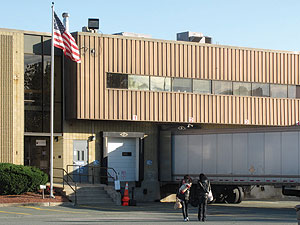
Under current plans, M.S. Walker Wholesale Distribution, which employs over 180 people on Third Avenue, will be one of the businesses that will have to go to make way for the Green Line Extension transportation and maintenance facility. - Photo by Elizabeth Sheeran
MBTA unveils site plans for GLX train yard
By Elizabeth Sheeran
Seventy-six vehicles. 17,000 yards of track. 130 workers. The MBTA’s latest plans for a Green Line transportation and maintenance facility in Somerville encompass a mind-boggling array of statistics. But the number that concerns some residents is this: four parcels of privately owned property that the T will take by eminent domain.
“MBTA is the largest land owner in Somerville and now they’re taking more land,” said Stephen Mackey, president of the Somerville Chamber of Commerce. “This is the most densely populated city in New England. We have a real stressful fiscal problem if you’re giving up land for no taxes. We’re taking tax-producing property, existing and potential, and giving it to them.”
Mackey was among residents who attended a community meeting on October 12 to get an update on the MBTA’s site design for the facility, which has been part of the proposed $1 billion Green Line Extension since the state first announced plans to extend the existing Green Line beyond Lechmere and through Somerville to Medford.
The planned facility covers 11 acres to the south and east of Inner Belt Road, just northwest of the commuter rail engine yard. When complete around 2019, it will be home base for nearly 80 Green Line cars and the 100 or more T employees needed to run them, including drivers and dispatchers. Another 30 employees will provide routine maintenance, from safety checks to parts replacement, operating 24 hours per day.
The MBTA originally proposed to build the facility to the west of Inner Belt, on land it owned next to the Brickbottom artists’ lofts. But it settled on the current site when residents and city officials fought the plan, saying it would have too negative an impact on both current residents and future neighborhood development.
The current “Option L” site is so-named for its shape, with its thinner branch stretching westward along the southern edge of the city limit, almost as far as Brickbottom. An 82,000-square-foot maintenance building, the facility’s largest structure, will now stand on the thicker branch of the “L,” which lies to the east of Inner Belt and extends as far north as Third Avenue.
Long-time Brickbottom resident Heather Van Aelst said she appreciated the site shift. She is encouraged by design steps the MBTA is taking to cut down on noise, like sound barriers and a track layout that minimizes how much switching will happen at the Brickbottom end of the train yard. But she’s still not wholly looking forward to sharing the neighborhood with a 24-hour maintenance facility.
“It’s still going to be a whole lot of tracks right around Brickbottom,” said Van Aelst, who works as a software engineer from her home office. “We’re always going to be concerned about the noise and vibration. It’s a lot of new trains and a new maintenance facility, still pretty close to us.”
Some residents at the meeting were still campaigning to push the facility location still further east, to the site of a large parking lot next to the commuter rail yard. “If the real answer is ‘Sorry, the commuter rail people just won’t consider it,’ then maybe that’s the answer, but please be transparent about it,” said Alan Moore.
MBTA officials agreed to meet with Moore and other proponents of the so-called “Mirror L” option, who say it would keep the T from taking away private land that generates property tax. Four private companies now own most of the land needed for the current plan, and two businesses will have to move, including 183 jobs at M.S. Walker Wholesale Distribution on Third Avenue.
The state estimates Somerville will lose over $400,000 in property taxes annually from private property that will be taken over by the MBTA for the Green Line Extension, and most of that is due to the property takings for the maintenance facility. But Mayor Joseph Curtatone said that’s a small price to pay for the long-term economic boost to the city. “It will pale against the amount of new commercial property tax revenue for the long term. The Green Line extension itself is a huge economic driver for the city,” said Curtatone.
Markey, of the Chamber of Commerce, said he agrees the Green Line Extension is a great thing for Somerville’s future, and he fully supports the project. But he said Somerville needs to keep pushing back to make sure the city is getting a fair shake. He noted, for instance, that the Somerville yard will house a disproportionate number of Green Line vehicles, including many moved from west of Boston.
“Now here they’re saying in order to get six stations, less than 10 percent of the service, we have to domicile more than 40 percent of the cars,” said Markey.
The next opportunity for the public to provide input regarding the Green Line Extension project, including the transportation and maintenance facility, will be on Thursday, October 20, when the state will present the results of its Environmental Assessment, beginning at 6 p.m. in the Somerville High School Auditorium on Highland Avenue. The complete report is available on line at www.greenlineextension.org.















Reader Comments